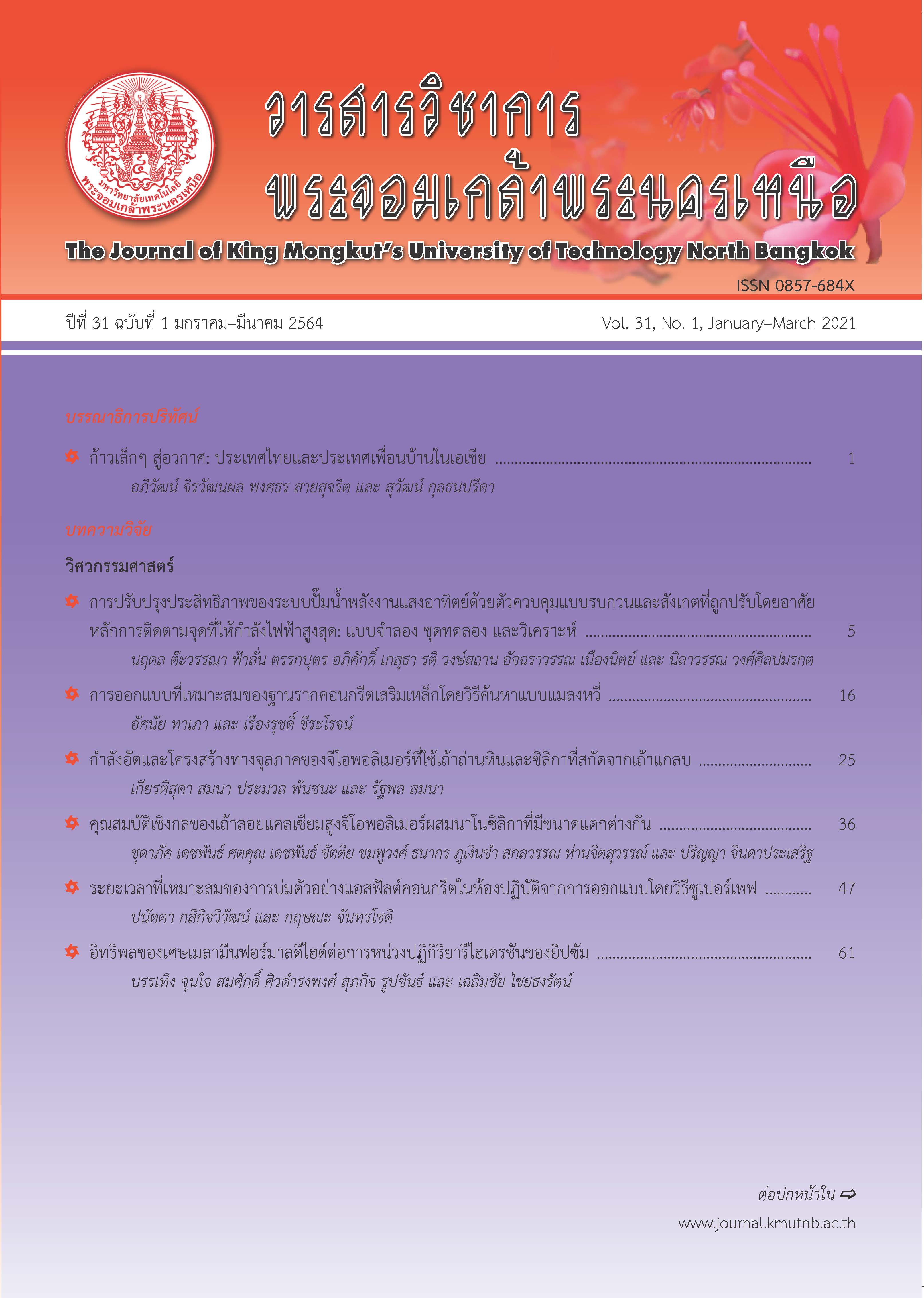กลยุทธ์การจัดการสู่ความเป็นเลิศในภาคธุรกิจอุตสาหกรรมอย่างยั่งยืน
Main Article Content
บทคัดย่อ
การเพิ่มประสิทธิภาพการบริหารจัดการของภาคธุรกิจอุตสาหกรรม มีผลต่อการเพิ่มขีดความสามารถในการแข่งขันของประเทศที่ยั่งยืน การวิจัยนี้มีวัตถุประสงค์เพื่อศึกษาตัวแบบกลยุทธ์การจัดการสู่ความเป็นเลิศในภาคธุรกิจอุตสาหกรรมอย่างยั่งยืน ดำเนินการวิจัยทั้งเชิงคุณภาพและเชิงปริมาณ สำรวจข้อมูลเชิงปริมาณจากแบบสอบถามผู้บริหารที่รับผิดชอบด้านระบบคุณภาพในองค์กร จำนวน 500 ราย ผลการวิจัยพบว่า กลยุทธ์การจัดการสู่ความเป็นเลิศ ด้านผู้นำ ได้แก่ การประพฤติตนอย่างมีจริยธรรม ด้านมุ่งเน้นลูกค้า ได้แก่ ยึดมั่นในคำสัญญาที่ให้ไว้กับลูกค้า ด้านการวางแผน ได้แก่ มีแผนกลยุทธ์ที่สอดคล้องในทิศทางเดียวกับเป้าหมายขององค์กร ด้านเทคโนโลยีดิจิทัล ได้แก่ มีกระบวนการป้องกัน และกู้คืนจากการถูกโจมตี และด้านพนักงาน ได้แก่ การสร้างให้พนักงานมีทัศนคติเชิงบวกต่อองค์กร ผลการทดสอบสมมติฐานพบว่า ธุรกิจอุตสาหกรรมขนาดใหญ่กับธุรกิจขนาดกลางและขนาดย่อม ให้ความสำคัญต่อกลยุทธ์การจัดการสู่ความเป็นเลิศ แตกต่างกันอย่างมีนัยสำคัญทางสถิติที่ระดับ 0.05 ผลการวิเคราะห์ตัวแบบจำลองสมการโครงสร้างที่ได้พัฒนาขึ้นพบว่า ผ่านตามเกณฑ์การประเมิน มีความสอดคล้องกลมกลืนกับข้อมูลเชิงประจักษ์ โดยมีค่าระดับความน่าจะเป็นของไคสแควร์ 0.064 ค่าไคสแควร์สัมพัทธ์ 1.118 ค่าดัชนีวัดระดับความสอดคล้อง 0.949 และค่าดัชนีรากของค่าเฉลี่ยกำลังสองของการประมาณค่าความคลาดเคลื่อน 0.015
Article Details
บทความที่ลงตีพิมพ์เป็นข้อคิดเห็นของผู้เขียนเท่านั้น
ผู้เขียนจะต้องเป็นผู้รับผิดชอบต่อผลทางกฎหมายใดๆ ที่อาจเกิดขึ้นจากบทความนั้น
เอกสารอ้างอิง
[2] IMD. (2018, September). World Competitiveness Yearbook 2018. [Online]. Available: https://www.imd.org/research-knowledge/books/world-competitiveness-yearbook-2018/
[3] R. M. Davisona and C. X. J. Ou, “Digital work in a digitally challenged organization,” Information & Management, vol. 54, no. 1 pp. 129–137, 2017.
[4] A. Jaeger, K. Matyas, and W. Sihn, “Development of an assessment framework for Operations Excellence (OsE), based on the paradigm change in Operational Excellence (OE),” Procedia CIRP, vol. 17, pp. 487–492, 2014.
[5] A. M. Carvalho, P. Sampaio, E. Rebentisch, and P. Saraiva, “Operational excellence as a means to achieve an enduring capacity to change – revision and evolution of a conceptual model,” Procedia Manufacturing, vol. 13, pp. 1328–1335, 2017.
[6] Moresteam. (2018, September). lean-six-sigma. [Online]. Available: https://www.moresteam.com/lean-six-sigma/lean-123-training.cfm
[7] P. I. Green Jr., E. J. Finkel, G. M. Fitzsimons, and F. Gino, “The energizing nature of work engagement: Toward a new need-based theory of work motivation,”Research in Organizational Behavior, vol. 37, pp. 1–18, 2017.
[8] M. Jankalová and R. Jankal, “Sustainability assessment according to the selected business excellence models,” Sustainability Journal, vol. 10, no. 10, 2018.
[9] J. C. Man and J. O. Strandhagen, “An Industry 4.0 research agenda for sustainable business model,” in Proceedings the 50th CIRP Conference on Manufacturing Systems, 2017, pp.721–726.
[10] T. Koch and J. Windsperger, “Seeing through the network: Competitive advantage in the digital economy,” Journal of Organization Design, vol. 6, no. 6, pp. 1–30, 2017.
[11] M. Rachinger, R. Rauter, C. Müller, W. Vorraber, and E. Schirgi, “Digitalization and its influence on business model innovation,” Journal of Manufacturing Technology Management, vol. 30, no. 8, pp. 1143–1160, 2019.
[12] Thai Industrial Standard Institute (TISI). (2019, August). Certificated Quality List. Information and Communication Technilogy Center. Bangkok, Thailand. [Online] Available: http://appdb.tisi.go.th/tis_dev/p7_iso9000/iso_info.php#
[13] T. Silpcharu, Statistical Data Analysis and Research by SPSS and AMOS, 18th ed., Bangkok: SR Printing Mass Product, 2020 (in Thai).
[14] I. D. Meza-Ruiz, L. Rocha-Lona, M. del Rocío Soto-Flores, J. A. Garza-Reyes, V. Kumar, and G. C. Lopez-Torres, “Measuring business sustainability maturity-level and best practices,” in Proceedings the 27th International Conference on Flexible Automation and Intelligent Manufacturing, 2017, pp. 751–759.
[15] M. Tickle, R. Mann, and D. Adebanjo, “Deploying business excellence–success factors for high performance,” International Journal of Quality & Reliability Management, vol. 33, no. 2, pp. 197–230, 2016.
[16] C. Hsiao, Y. Lee, and W. Chen, “The effect of servant leadership on customer value co-creation: A cross-level analysis of key mediating roles,” Tourism Management, vol. 49, pp. 45–57, 2015.
[17] O. A. Garba, M. T. Babalola, and L. Guo, “A social exchange perspective on why and when ethical leadership foster customer-oriented citizenship behavior,” International Journal of Hospitality Management, vol. 70, pp. 1–8, 2018.
[18] T. Feng, D. Wang, A. Lawton, and B. N. Luo, “Customer orientation and firm performance: The joint moderating effects of ethical leadership and competitive intensity,” Journal of Business Research, vol. 100, pp. 111–121, 2019.
[19] N. A. Lawrence, “Driving strategies in performance excellence,” Doctor of Business Administration, College of Management and Technology, Walden University, 2017.
[20] D. Hardcastle, A. Ioannilli, and J. McLinn. (2017, January). A Customer-Centric Approach to Commercial Excellence, (Leading oil, gas and chemical companies are unlocking new value by improving customer experiences and loyalty), Bain & Company Inc., [online]. Available: https://www.bain.com/insights/a-customercentric-approach-to-commercial-excellence
[21] S. Markovic, O. Iglesias, J. J. Singh, and V. Sierra, “How does the perceived ethicality of corporate services brands influence loyalty and positive word-of-mouth? Analyzing the roles of empathy, affective commitment, and perceived quality,” Journal of Business Ethics, vol. 148, no. 4, pp. 721–740, 2018.
[22] T. Vongmahasetha, “Content marketing exposure of online consumers in Bangkok area,” Journal of Business Administration, vol.7, pp. 85–94, 2018.
[23] G. B. Oluoch, R. Nyonje, and L. Awiti, “Total quality management practices and service delivery in healthcare in public health facilities in Kisumu East Sub-County, Kenya,” International Journal of Academic Research in Business and Social Sciences, vol. 8, no. 3, pp. 619–637, 2018.
[24] P. GuarienteaI, I. Antoniolli, L. P. Ferreira, T. Pereira, and F. J. G. Silva, “Implementing autonomous maintenance in an automotive components manufacturer,” in Proceedings Manufacturing Engineering Society International Conference 2017, 2017, pp. 1128–1134.

